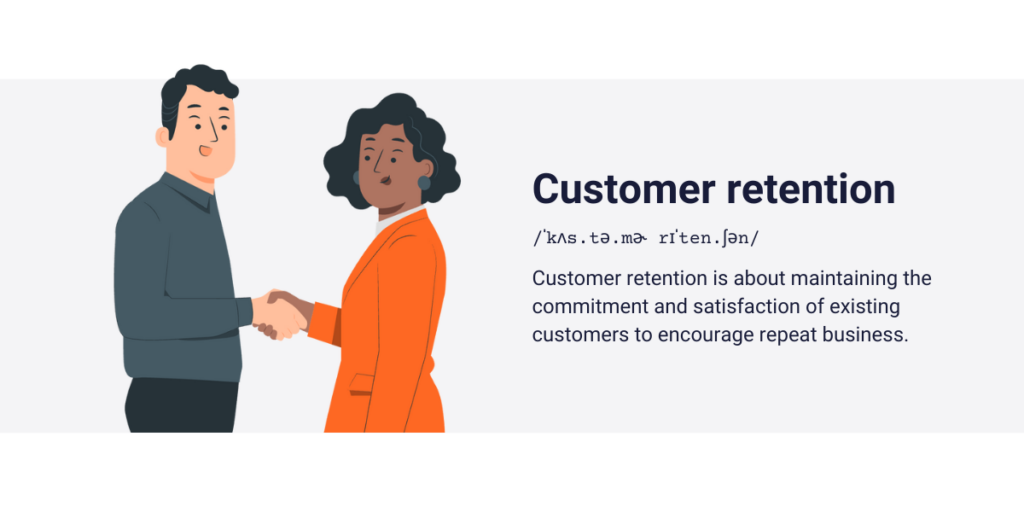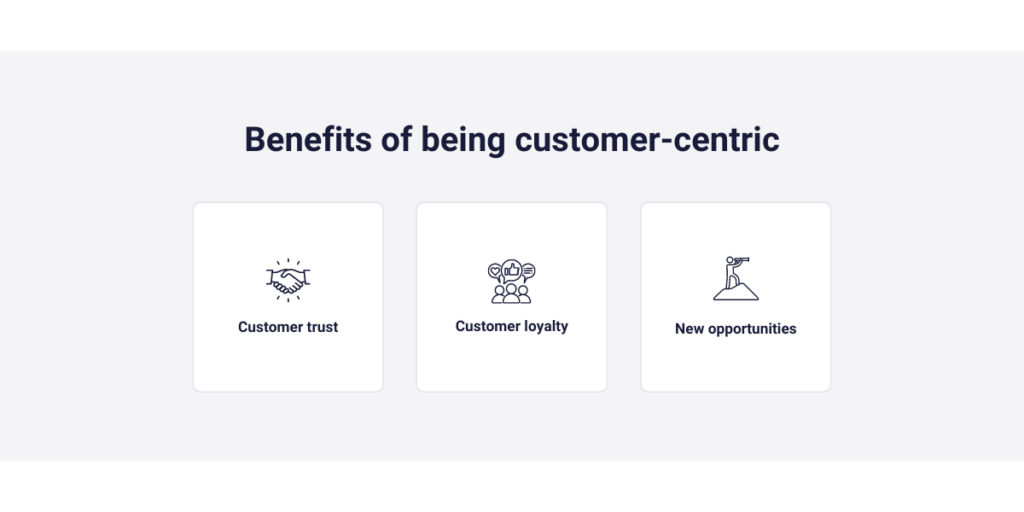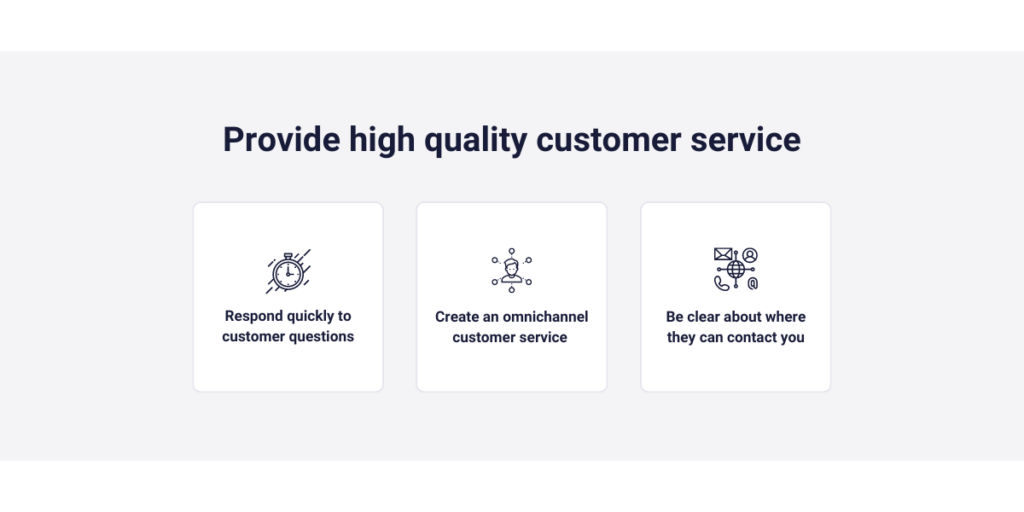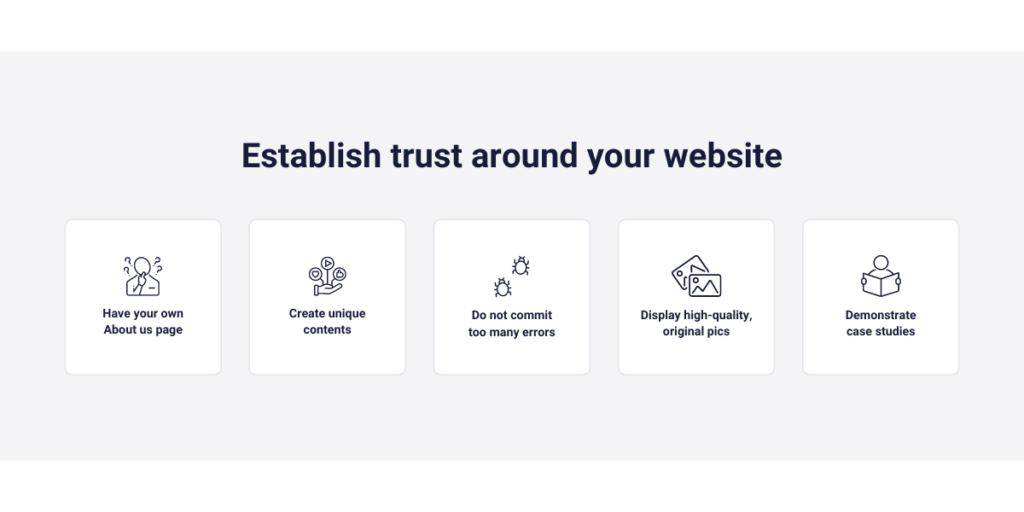Years ago small businesses didn’t require a website. Of course, in some industries, it was a necessity, but those were the exceptions rather than the standard. In the last couple of years, it took a radical turn. Now, you better have a website as a small business owner for several reasons:
- It boosts your business’s credibility
- It expands your company’s physical location
- It shows that your business actually exists
And last but not least: It’s crucial in our digital world. Let us share some statistics with you. In 2021 about 7 out of 10 small businesses have already created a website. On top of that, 50% of those who didn’t have one at that time, mentioned that they would be happy to create one sooner or later. These are all coming from Clutch’s report.
In 2024, a small business that doesn’t have a website is basically destined to die. However, even if they create one, the number of arising problems won’t start to decrease. They usually struggle with low traffic, lack of time to invest in maintaining, and improving, and the lack of customer retention strategies.
In this article, we try to give some tips on the last given problem, but let’s start from the beginning.
Table of Contents
What is customer retention?
“Customer retention is the capability of a brand to keep its customers over a given period. A successful customer retention strategy ensures that customers are well-informed about the brand and fosters loyalty, leading to repeated purchases.”
So that being said, customer retention focuses on giving a better user experience to your buyers to convince them to repurchase rather than having new and new buyers all the time.
Also, we need to meet with two formulas that come from customer retention. That is the customer churn rate and the drop-off rate. Meanwhile, both formulas measure the percentage of loss in some way, but they are different.

The churn rate refers to the percentage of customers who stop using a product or service within a specific period. So, if you had ten customers, but six no longer buy anything from your online shop, your churn rate is: 6/10*100= 60% → therefore you lost 60% of your buyers.
On the other hand, the drop-off rate is heavily used by data analytics companies. Refers to the percentage of users who abandon a specific process before completing it. So, if you had ten visitors on your site, but only 2 two of them reached the end of the conversion funnel, your drop-off rate is: 6/10=60% → therefore you lost 60% of your potential buyers.
With this comparison, the differences are trivial. In customer retention, we only use one of them: the churn rate to analyze the size of our success.
Why is customer retention important in the case of small businesses?
The main relevance of customer retention is the following: Studies show that it takes 5 to 25 times more resources to convince a new buyer for a possible purchase than an existing buyer from a possible repurchase. The difference is huge!
In the case of a small business to stay up, and not let the deep water grab you, you need to focus on minimizing business costs. So, even if you would be happy if you can only rely on first-time buyers, you can’t afford that. Or if you can, you no longer need to categorize your company as a small business.
On top of that, not just the reduced cost is the one and only reason to focus on customer retention. According to Forbes, there are two more reasons why businesses need to care about customer retention:
- Loyal buyers trust you, and they are 50% more likely to try a new product from you than a first-time buyer.
- Existing customers tend to spend more on your site by 31% than new customers. We can also connect this behavior to the increased credibility loyal buyers have.
9 customer retention tactics for small businesses
Boosting customer retention does not come from nothing. It is like a relationship: both parties need their time, and energy to create something extraordinary, and longevity.
Although customers need to put effort into establishing a great connection, the business needs to make the first few steps. And even if it’s far from easy, we have some good news. In this article, we will share nine tips with you that can convert first-time buyers into loyal ones, and make them want to be part of a community. Well, not just a community, a family!
1. Be customer, and not money-orientated
Most of the business’s biggest objective is realizing profit, and they put everything under that. The customers are just a tool that helps them to reach that. Thinking and acting based on this norm leads companies to failure.
These days, way more businesses have an online presence than in the early days of the internet. That’s true in every industry. Don’t forget: it only takes a few clicks for a customer to change sites and buy the products elsewhere. That being said, customers are aware of their value, and they desire to be listened to, and appreciated.
Customer-focused companies first examine how their decisions impact customers and then how it impacts their profitability. Their main goal is to establish a positive relationship with the buyers in the long term, and the rest comes just on its own. Research shows that client-centric companies are 60% more profitable than others.
And what you will get as a reward from your clients in exchange?
- Customer trust
- Customer loyalty
- Opportunities
Based on that, a good seller-buyer connection is the first step in building customer retention.

2. Offer customer service to increase customer retention
Of course, one aspect of boosting customer experience is to establish customer service.
Imagine that there is an issue in connection with your website, your products, or the delivery itself. Or your visitors have crucial questions in order to complete the buying procedure. Ignoring customer service as an option, you not only let your customers be frustrated. But, there’s a higher chance that they get bounced from one of your funnels even before completing a goal.
According to Salesforce’s 2023 research, 88% of buyers are more likely to repurchase from a brand that has customer service than from those who don’t. As you can see, this is a game-changer for your business profitability. With well-equipped customer service, your buyers are more likely to rely on what you sell, therefore you can convince them easier for a possible repurchase.
Well, you need to establish a customer service sooner or later that’s undebatable. However, just writing a phone number on the bottom of your site, with the text saying: “Call this number if you need help” – won’t enhance customer retention.
Try the following tips:
- Create an omnichannel customer service (the visitor can find your customer service on every channel the company is available)
- Reply fast! Try not to let the customers wait too long, as they quickly get offended by your inactivity. In our fast-paced world, there’s no time to ignore questions, even in the case of a small business
- Be clear about where to contact you! Highlight it on your website where they can reach you, and don’t let them get stuck, or get lost.

3. Increase the user experience with gamification
Sometimes, there are just too many competitors. The bad thing is, customers may just only check the prices, and buy the product on that website where it is the cheapest. Out of this activity, customer retention never really comes into the picture. You can’t always be the most budget option. But, if you make your prices higher, other websites will grab your customers.
How can you create customer retention, without setting your prices lower and lower? Or just keeping your prices low for too long?
Well, gamification is certainly an option. Gamification means different in-game techniques to be implemented in a non-game environment. This can be a leaderboard, badges, rewards, or points which all motivate the user to spend more time with the game, or in this case, with your website.
The good things about gamification are that it is cheap to implement – even for a small business -, and enhances the user experience. Gamification can make buying time more fun. When first-time visitors realize this, they want to feel this many more times.
However, a well-organized gamification update has so many requirements:
- Have clear objectives
What is the purpose of the implementation and what do you want to achieve?
- Understand your target audience
Who do you want to reach? – younger generations resonate more with gamification than older ones.
- Create valuable rewards
What rewards do your target audience personally describe as “valuable”? It’s hard to find those incentives that are meaningful to your target audience, but not too big to lose too much money.
- Design for better results
How should this feature look to perfectly align with your website’s design and characteristics?
- Make regular updates and bug fixes
What did not work in the first phrase, and how do we fix them?

4. Create in-email surveys
According to a statistic, for every customer who complains about a business, 26 customers don’t say a single word, yet these are still unsatisfied buyers. It would be helpful for a company to hear their voices since these can help the company decide which features are helpful, and which are not. Or, these can discover bugs, rude employees, and other problems that are currently not under the radar.
You have several options to understand their behavior:
- Make on-site surveys! That’s not that efficient. Customers who store negative memories from your company are less likely to appear on your site at that time.
- Track your customers’ behavior with data analytics software. The heatmaps, and session recordings can definitely help you to discover hidden problems, but you don’t get these responses directly from the buyers.
- Create in-email surveys, and ask your buyers about their satisfaction, and possible problems later, in a second platform.
In this case, even if they are not staying on your website, they still get notification about your survey.
With Capturly Analytics’s in-email survey, you can get access to your buyer’s Net Promoter Score (to understand how likely they are going to recommend you), or you can send follow-up emails to ensure the addressed notices the letter. You can also rewatch their sessions to get a complete view of the reason for their frustration!
Customer retention can’t move to a higher level without fixing your mistakes, and increasing buyer satisfaction. Well, if you know your buyer’s thoughts you have better chances to create your site based on their wishes. Therefore you will convince more first-time buyers to be loyal ones.

5. Aim for quality over quantity
In recent years, a trend has come up that conquered the whole online market. People love when they are noticed, and businesses take care of them – personally – . You can’t sell more and more products all the time. Every company has a serviceable available market (TAM), which means the maximum number of people that the company is able to serve with its strategy.
The truth is, you can’t go further, and sell to more potential buyers than this. Only if you change your products, move to other regions, or redefine your strategy. That’s why you need customer retention to promote your products to those who once bought from you. And providing a personalized experience for your buyers!
Customers want a personalized experience, even if it means they need to spend more. According to a questionnaire, 90% of the buyers believe that personalized experience is desirable to them. However, the way you can establish a personalized experience on your website depends on the actual industry you are in. Sometimes you have more opportunities, and sometimes less. But the thing is: there are some standard techniques which you can almost always work out!
For example:
- Product recommendations before or after the purchase
- Group customers based on their shopping history
- Offer targeted discounts and promotions
- Personalized messages based on locational data

6. Establish trust around your website
One of the main reasons why customers don’t want to buy from you again is because of your lack of credibility and reliability. Unfortunately, small companies tend to spend less on this category. Why? They just simply don’t think about this segment too much, visitors will see that they want to give value in exchange for their money.
However, potential buyers may move back from buying if they find something suspicious. Lack of certifications, no displayed customer feedback, no HTTPS securement. Neglecting these aspects will power these negative feelings.
The option to pay at the delivery time, or to have a cash payment option all increase the trust on your site.
Other ways to increase trust are:
- Have an About us page, with additional business information
- Create unique contents
- Do not commit too many errors
- Display high-quality, original pics
- Demonstrate case studies
Of course, implementing these tips not only leads to more first-time buyers. Even if customers bought a product from you that they didn’t find on other sites, they will choose the more credible the moment you both sell the chosen product. And after a completed purchase, they can still question your professionalism and customer-based thinking.

7. Create a customer loyalty program
There are two options, pick the one that you think is more efficient!
- The same prices, products to anyone
- Loyal customers are rewarded
Price discrimination based on the periods of two purchases from the same buyer is a general solution. Those buyers who have less time between two of their purchases may be eligible for better rewards.
There is a calculation called the Customer Lifetime Value. It estimates the total net profit a company can gain from one of its clients throughout their entire relationship.
Your task is to maintain these relationships as long as you can. However, they won’t pick you always, if you don’t appreciate their behavior and loyalty from time to time. And they don’t necessarily want thankful messages, but incentives, rewards, discounts, or exclusive offers.
A good opportunity is a point system. After every purchase, they get points based on the money they spend. With the gathered points, they can redeem offers, which make their life easier.
8. Surprise your buyers!
The human brain loves surprises. Emory University Health Sciences Center concluded this in their 2001 research. This statement not only refers to children but adults also. Think of it when you meet with an old friend on a bus, or when your friend surprises you on your birthday.
Surprising the buyers covers a long scale, and even small surprises can lead to huge positive consequences. A short personalized thank-you message after a purchase can significantly boost your chance of reaching a possible second purchase later from the same buyer.
But, same as giving gifts to friends, you first need to analyze what they need. One of the best ways to know more about your visitors is via online analytics. For instance, Capturly Analytics’s software has both heatmaps and conversion funnel analytics capabilities. With the help of that, the tool can demonstrate to you where your potential buyers click the most, and the percentage of users that get bounced at one part of the funnel.

Why is this good for you? Imagine that your users click on a CTA to buy a product, but after they are faced with the delivery time, they don’t successfully go through the macro conversion.
As a surprise, you can decrease the time for a short time period, even if it costs you more than your potential revenue from that act. After you communicate this surprise efficiently and deliver this message to all of the interested target groups, you can win huge.
Why? Just think: you convinced the buyers to go up on your site, without spending too many crucial resources. This is especially a must-have feature for small business websites, as building a personal relationship with the few buyers that you have at this moment is a key to growing.
9. Do transparent communication
Customer retention for small businesses is not all about giving your buyers more and more rewards. You can’t take that financially for too long. You need to go with other plans that concentrate on your business reliability. Don’t forget: people see through those promotional charity events that are held to make the company more popular and accepted.
In the case of a small website, you can’t communicate “A”, and make the “B”. Don’t get me wrong, no website should ever do that, but a bigger one can erase the mistake from the customer’s brain with huge marketing campaigns. That’s what you can’t afford when you are small.
By openly sharing information about products, services, and company policies, businesses build trust and credibility with their customers. Don’t be afraid to provide insights into the company’s financial situation, workplace affairs, or even negotiations of a possible merger, or investments.
You may think that you don’t need to show pictures of your workplace environment, but people love companies that stay on the ground and remain friendly. People also love vulnerability: try not to hide embarrassing moments, or news as those have never happened. Say sorry for your mistakes, and ensure that those things never happen again.
For efficient transparent communication, every small business website should establish its own blog. This sub-page should be reached by your main page, and the visitor should be able to find that without too much searching. You need to update your blog weekly, share new and new parts of the company’s daily life, write articles about the business’ goals, and values, and create valuable content about topics that your potential buyers are interested in.
Conclusion
In this article, we discovered the definition and the importance of customer retention, specifically in the case of small websites. After that, we shared 9 tips that can help convince existing buyers to put their boots on and make an unforgettable journey to your online world.
Be aware: don’t make decisions based on just the financial profitability of the decision, but examine that first from the buyer’s perspective. If it’s the opposite that you want to implement, it won’t be worth it in the long term. Don’t change short-term success for placing your clients in second place, as customer loyalty will end the very first minute when a better offer knocks on their door.
Customer retention refers to a company’s ability to keep its customers over a period of time, maintaining their continued engagement and loyalty to the brand.
Convincing first-time buyers is more cost-efficient than convincing existing buyers of a possible repurchase. It is important for a small website to remain cost-efficient, and they can’t afford long, and expensive marketing campaigns every new month.
Based on the latest trends and research, personalization and establishing a reliable company are the two best strategies for convincing buyers for a possible repurchase with limited money.
Small websites can personalize the customer experience by offering product recommendations based on previous purchases, grouping customers based on their shopping history, offering targeted discounts and promotions, and sending personalized messages based on locational data.
Improving user experience can be achieved by ensuring the website is easy to navigate, mobile-friendly, and fast-loading. Additionally, providing clear product information, an intuitive checkout process, and multiple payment options can enhance the user experience and encourage repeat visits.
Don't forget, sharing is caring! :)

